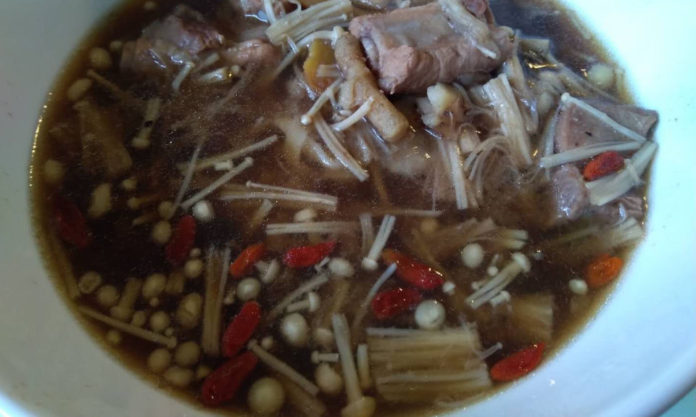The English language wouldn’t be as careless as this.
Sure, 汤 (tang) is “soup” but this character also gets used for fruit juices, as in 酸梅汤 (suan mei tang); sour plum juice.
There’s also 茶 (cha); tea, which means “processed-Camellia-Sinensis-leaves” and “drinks-infused-with-those-leaves”, right?
Well, not quite, because there are other roles for this character, too.
There are those Chinese drinks using the leaves (and flowers) of other plants. In Beijing’s impromptu Temple Fairs, I have drunk a 茶汤 (cha tang); tea soup, which is a glutinous, sugary, sesame-flavoured thing much better than it sounds. No leaves in sight, though.
And then there’s this 肉骨茶 (rou gu cha); meat rib tea, a savoury soup containing a whole host of Chinese Medicine plants, but no Camellia Sinensis among them. It’s often known by its Hokkien name; bak kut teh or bakuteh.
I was switched on to making this tea-that-isn’t-tea dish by our dear editor. As well as pointing out the strange name, he said it can taste good.
Hoping to find a complete packet or bouquet garni, I was disappointed by the supermarket.
Fortunately, ours is one of those supermarkets with doors hidden in a labyrinth of stores and concessions. Mostly shut since the virus, one of these stalls has survived; the one selling tree bark and dried lizards. Perfect. The seller was able to give me two of the remaining ingredients on my list, though there was still one she’d never heard of!
I now had the black and tarry (熟地黄; shu di huang), foxglove root, 川芎 (chuan xiong), and Sichuan lovage that’s like cat scan slices of wooden walnut. One pungent package! I put these into the big pot with the pork ribs. Red dates and goji berries we already had, even a fresh stick of yam! I added enoki mushrooms and garlic and ginger, all in big form factors.
Gas on, it was soon squealing.
And the effect in the house was not so much fragrant as flagrant. Highly-charged stuff!
I confess that this first version added some noodles to everyone’s bowl before serving. This is not an everything-but-the-kitchen-sink dish and I regret approaching it that way. Also, I should have used the pressure cooker which my wife employs to such great effect.
The meat was not tender enough. And though it was clever of me to leave the goji berries and mushrooms to late, the yam had disintegrated. Room for improvement. But I do intend to repeat this experiment; the promise is there.
This dish is often associated with Malaysia, so I shared my thoughts afterwards with a much-loved Malaysian friend. As well as pointing out my mistakes, he said that this dish’s origins and identity, like his, are Chinese. It was immigrants to those regions who brewed up this nutritional/medicinal herbal hybrid.
Labourers working in year-round tropical heat.
He describes it as a kind of legendary “magic potion” or “energy drink” specifically intended for such workers, not given to the old or infirm. He also suggests that the tea identity comes from the common pairing of this soup at the table with tea.
In the UK, I could easily say that I “had this soup for my tea”; that’s just the casual name for any evening meal. Actually, Chinese and Americans too will recognise “afternoon tea” as an event, as a tower of light foods. There is even a biscuit called “Rich Tea”, containing not one leaf. Yes, the English language definitely can be careless.









